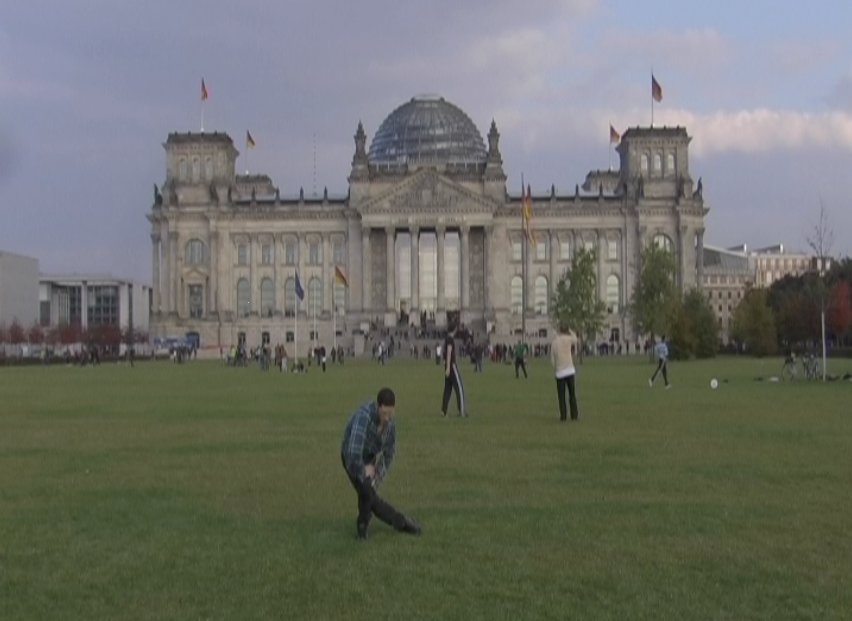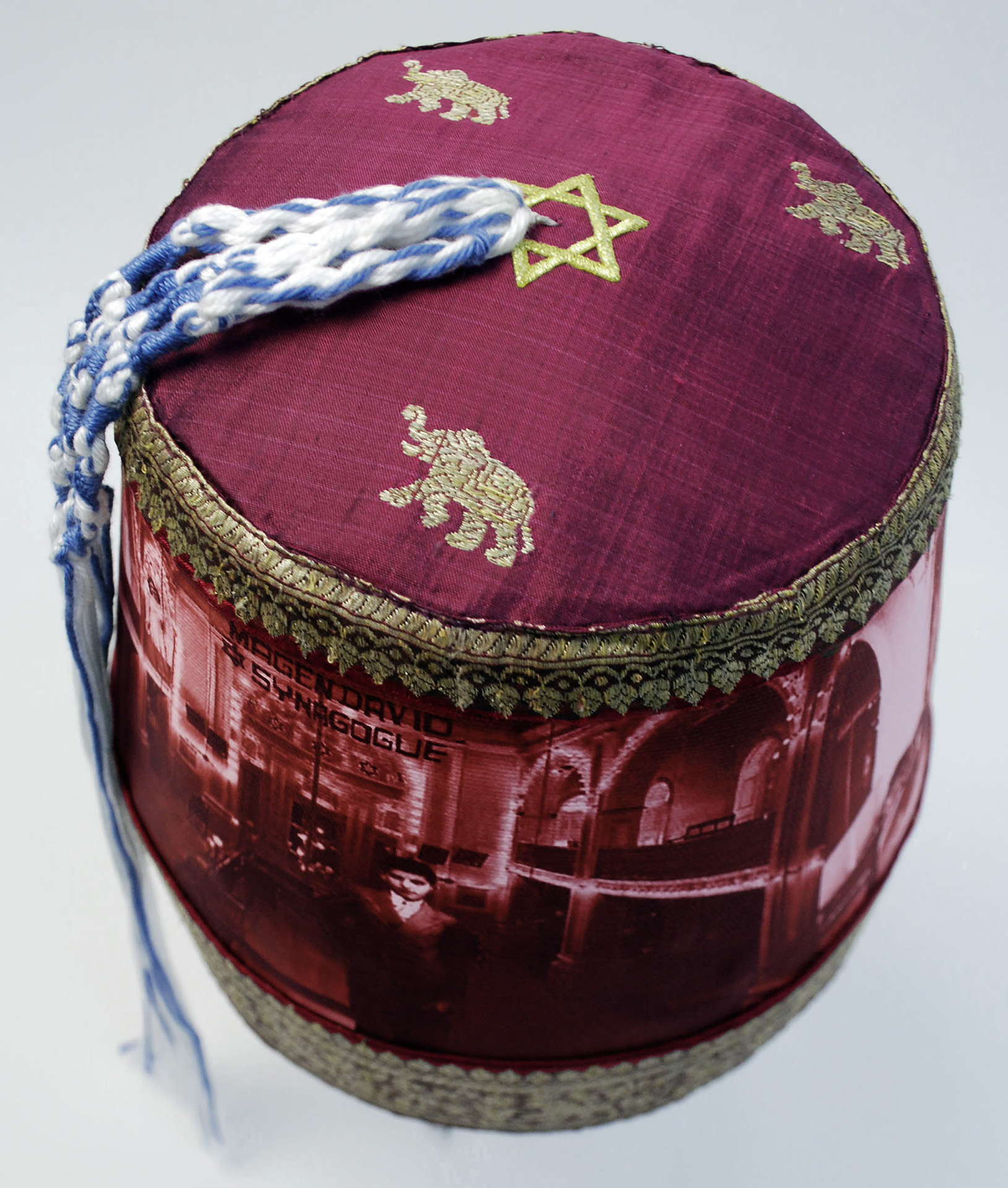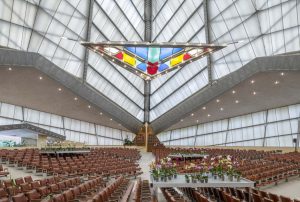
In the fall of 2019, David Hartt installed artworks across multiple floors of Congregation Beth Shalom’s synagogue, originally designed by Frank Lloyd Wright, in Elkins Park, Pennsylvania. The installation The Histories (Le Mancenillier) is the first of a three part cycle of works, the culmination of Hartt’s historical research on the Americas and the Caribbean during the 19th century. This first work, installed in a temple, is the occasion for our conversation below.
Hartt uses his own method of carefully selecting materials to form an architecture of migrations (of peoples, plants, and cultures) temporarily transplanted to the synagogue. He categorizes his work in open phrases: ciphers, synthetic individuals, singularities, unstable concepts. These heuristics indicate his aspiration that the people and places of 19th century New Orleans and Haiti have more to say in (and about) present-day Philadelphia.
Ambisonic digital audio, video art, organic art — Hartt’s work defies classification. His juxtapositions reformat artwork to speak by way of ambience rather than event. The Histories is a counterpoint to Wright’s monumental design. In the conversation below, Hartt guides us through his temporary constellation of representations, apparatuses, performances, and experiences. His careful descriptions guide us to resist the interpretive impulse toward closure. His belief in the agency of materials to speak, however quietly, cultivates a meditation worthy of a templum, an open or consecrated space.
The musical piece from which the work derives its parenthetical title is Louis Moreau Gottschalk’s 1851 composition Le Mancenillier, which refers to the manchineel tree, also known as the beach apple tree or little apple of death. This was a common tree on Caribbean shorelines that European seafarers, colonizers, and mariners feared greatly. When I learned this history, I thought of the Haitian Revolution, Bois Caïman, and the revolutionary use of toxicology as a method of interruption and sabotage. I thought of Hartt’s work as another type of interruption: sabotaging the potential enclosure of Jewish histories from others.
—
Rudy Gerson (RG): After your installation opened at Beth Shalom, a panel was organized to discuss the work. There, you said you wanted to find “new ways to occupy or understand the space that were rooted in the history of the space, but that didn’t have a kind of presence to announce themselves.” This is a clear, but still open ambition. Can you speak to how you arrived at your chosen materials?
David Hartt (DH): Usually I choose sites because they are exemplar of a particular set of conditions I’m interested in investigating. I call these unstable concepts. However, in this case, the site was chosen for me. Rather than accept the conditions of the prevailing narratives of the site, which focus on Frank Lloyd Wright and his relationship to the congregation, I thought, “How would I approach this more objectively?” I found the clues in the history of the congregation, in the fact that the congregation had migrated from the Logan neighborhood of Philadelphia, and that their former building is now occupied by a Black Evangelical congregation. I thought, “What a fantastic way to bring two very different communities and diasporas into conversation with each other.”
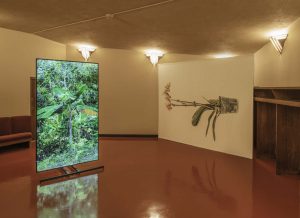
This was the way within which I could open up the work and also question the capacity of a building already occupied by an active congregation to also host this very different idea of community. This led me to make films in New Orleans and Haiti in order to bring the histories present at those sites into the foreground of the building itself. The scale of the works, the materials, the way I approached image making — all of that was with the intention of transposing one site onto another, one community onto another.
RG: I want to consider this history of suburbanization within a history of white flight and I wonder how this congregation is implicated in that. I wonder how your work is an occasion to think through that history. Looking at the Logan neighborhood today, there’s about 5% white residents. How might the Great Migration be important in this work, especially as we consider urban geographies during the period of time leading to the 1950s?
DH: First, for me, the idea or the phrase “white flight” is racially charged in an unhelpful way, suggesting and prioritizing one set of movements usually at the expense of another. I instead think that these things are deeply relational. As you know, there was absolutely a migration to the North in a much earlier period and also in the post-war period. But what I try to do is acknowledge all of these movements as contingent. “White flight” prioritizes and in some ways sensationalizes these patterns. At the same time, these movements are distinct in terms of the diasporas that I’m describing. I felt that the Black diaspora and Jewish diaspora at a global and national scale was too broad.
The site acts as this extremely dense point of entry into an ideological position. These places in the world are what I call “singularities,” where unstable concepts are fundamentally in crisis. In trying to resist the overwhelming and prevailing narrative of Beth Shalom, I wanted to insert other characters to help us navigate these diasporic journeys. I identified a few ciphers, individuals through which we begin to understand the conditions of a time at a place other than the present.
RG: Can you say more about these individuals?
DH: I call them “synthetic individuals,” individuals that have a capacity to apprehend and blend multiple concepts to produce something new. They provide a kind of extremely compressed form of seeing and understanding the world.
Louis Moreau Gottschalk, who was a New Orleans-born pianist and composer, is one of those synthetic individuals who allowed me to think productively about these two kinds of intertwined, diasporic journeys. Gottschalk was raised in New Orleans, after his mother’s family left Saint-Domingue during the Haitian Revolution. His father was a slave owner who had an affair with Judith Françoise Rubio, a free-black woman. He had a parallel family with multiracial step-brothers and sisters. Without going too far into his biography, it’s enough to say he was an extremely complicated individual who experienced ideas of race in a complicated way.
He was the first classical musician to both recognize and celebrate Afro-Caribbean and African-American musical traditions. What’s important to me is how we begin to see and understand the world through his work. The crux is how these complex ideas of race, place, and historical perspective are synthesized within these individuals’ works, within their painting or music or literature. Each of these ciphers manages to weave together a moment that’s in crisis but also evolving. Through them, we get a better understanding of the significance of the changes happening.
RG: What’s striking to me in the documentation of the installation is how the piano is occupying the space. Maybe because of the particulars of my Jewish upbringing, I wouldn’t normally consider the piano as an instrument one finds in synagogues. Can you say more about Gottchalk’s composition and the placement of the piano in the installation?
DH: The score was recorded and performed by Girma Yifrashewa, an Ethiopian pianist from Addis Ababa and an incredible musician and composer.
Girma interpreted four pieces, and we made a complex recording at a sound studio with nine microphones placed across different parts of the piano. In the installation, the recordings are broadcast over four speakers in the upper floor of the sanctuary. We spatialized the sound so that it felt as though you were within the piano itself, that the instrument was the building. That’s very different than the instrument being in the room.
We also developed five programs with Jean Bernard Cerin, a Haitian musician and vocalist who put together programs of traditional African-American, African, and Jewish folk music as well as art music. During those performances we used the piano and the microphone. In fact, we closed off that room and broadcast the performance into the sanctuary because I wanted to avoid having the conditions of the installation change as a result of the spectacle of performance. It was a radio show, but live and in the same building.
To go back to your comment, the piano is actually the congregation’s and is used for practice by the cantor, so we just moved it from one room to another. The piano is one element in a broader array of moves that I made, and it’s really difficult to isolate it as something singular.
The tapestries and their installation both accented and worked against Wright’s concept of total design. The same thing with the video monitors. I like to think of them as these interspace portals. One of the other things that is almost imperceptible is that we changed all the light bulbs on the ground floor to an amber low-wattage light. It cast everything in this beautiful golden glow.

Additionally, there were artificial plants in the planters. We removed those and put in plants native to New Orleans and Haiti. We had to use artificial grow lights, so there’s this beautiful counterpoint between the amber light and the fuchsia of the grow lights. The piano is one element in a really complex array of different pieces that are acting in unison to really transform the space.
RG: Another historical work you mentioned on the panel is the Hubert Robert painting Imaginary View of the Gallery of the Louvre as a Ruin. In it, we see France’s Louvre museum, a kind of secularized temple, become rubble. You use orchids, visual icons of Victorian luxury and refined taste. They’re well-maintained but also suggest a rewilding to come. How do you see the orchids laboring in the synagogue?
DH: When I visited the building after a rainstorm, there were 70 buckets and three kiddie pools collecting the rainwater from the ceiling, which leaked abundantly. I realized that if I was going to do anything in the sanctuary space, I needed to address that. Otherwise, after a rainstorm, whatever I put in that space would end up being surrounded by that mitigation system.
What I usually do is evaluate existing conditions and use them as catalysts to think through potential ways of working with a space. The water leaking in the containers was a catalyst, but also the significance and beauty of the space itself.
Martin Johnson Heade was a contemporary of Gottschalk and had met him. Heade was traveling through the Caribbean and South America, making paintings of these Victorian curiosities, hummingbirds and orchids, and then bringing them back to the US. I wasn’t so much interested in that operation, taking the image and circulating it in the North. What I was more interested in was the plant itself, and having found it through Heade was compelling.
I see the orchid as a diasporic plant, because it doesn’t put down a conventional root structure but rather attaches itself to an existing infrastructure and absorbs its nutrients from the air or moss. Whether it’s wrapping itself around a tree limb or a destroyed and decayed building, the orchid is kind of neutral in terms of the host as long as the orchid can attach itself and find adequate nutrients.
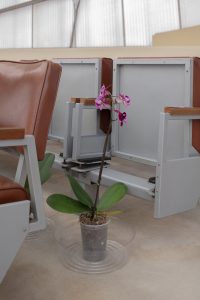
I love this idea of using the orchid as a diasporic creature that roams throughout the sanctuary and finds purchase in these different places based on the leaking of the building. I assembled over 200 orchids on suspended oversized planting beds, about 10’ by 12’ each. At the beginning of the exhibition, the orchids were all placed on three planting beds, and over time the custodial staff was instructed to move the orchids to capture the waters that came in. Each time you visited the exhibition, the plants would be in a different place in response to the conditions of the building.
The other thing is, as you alluded, they’re incredibly beautiful living creatures. Spending time quietly with them as the music plays and the light comes through the glass roof is a transporting experience. Regardless of one’s religious affiliation, one can feel a sense of awe and grandeur.
The other thing too is that it’s not singular. It’s not asking you to look at this one thing. It’s about spending time in a space and being sensitive to the conditions of the space, which I think is unique and not all art provides that. It was a space where one wanted to spend time regardless of what I put in there. Anything I would put in there would simply be an adornment to an already magnificent space.
RG: From the images, it’s difficult to represent the simultaneous operations happening across different scales in the multiple spaces of the temple. I’m led to a question around ethics. What happens when one does art in what we’re going to call a place of sanctuary and prayer?
I’m interested in you reflecting also on your other two works in The Histories series, which were both presented in formal art spaces — the museum or gallery — and specifically the kind of ethics that might change between presenting in these religious spaces of prayer and in art spaces. Are there any tensions or questions you have about this?
DH: First, it’s important to state how I see architecture functioning. I see it as essentially a container within which the practice of everyday life is enacted. Buildings are usually built with a specific purpose in mind, but any building that is well made and worth preserving also must adapt. Consequently, how different communities occupy that space and what they do with it is for me one of the important criteria for understanding architecture’s potential.
Secondly, I don’t see any kind of ethical quandary. You know, Frank Lloyd Wright was an artist, and Beth Shalom is a work of total design. Wright designed every aspect of it — from the furniture to the structure itself to even some of the ceremonial objects active within it.
There was space for other artists’ work too, on the walls and in the adjacent building that houses the school there is a beautiful stained glass piece. There are sculptures, drawings, paintings throughout all of the buildings. The role of art within these structures is to both celebrate and document the community, and I don’t see that as different from the works we see in institutions like museums and galleries. It’s consistent in terms of what art attempts to do regardless of the space it inhabits.
The synagogue as a sanctuary, to go back to an earlier comment, also represents this idea of a singularity, where one can occupy an extremely concentrated concept of an ideological position. A feeling of belonging to a broader community is perhaps a way of articulating that ideology without necessarily going off into particular belief systems.
RG: As you said, orchids don’t grow in soil but typically in bark, so I also understand them as a metonym for trees. And when I think of trees in the context of the synagogue, I can’t help but be reminded of how I, as a young person in Las Vegas, was taught that Israel “made the desert bloom” through Tu B’Shvat. I was given this sense that the desert is an empty, unproductive wasteland and “we Jews” are helping care for the earth through planting trees. But reflecting now, I’m considering the parallels between these Victorian orchids imaged in the Caribbean, the synagogue in the United States, and the afforestation of settlement projects that displaced Palestinian people from their land. Your visual juxtaposition provoked this. So I’m thinking about the educational structures of synagogues and how your installation disrupts, interrupts, or arrests the symbols concretized in a generation. I found the orchid in the sanctuary such evocative material.
DH: It’s also not the only plant life in the installation. Remember the tapestry and the plants native to New Orleans and Haiti in the lower level? So the orchid is just one part.
I’ve talked about this in other work, this idea of terraforming as a parallel component to colonization. The occupation of the land occurs through the rearticulation of the landscape to perform specifically for the settler community, even if it means the eradication of whatever was there before.
I like the idea of the space being this kind of negotiation between the two communities. The idea of the South isn’t simply contained within the monitors and the tapestries or the music. There’s also an encroachment by the landscape itself through the transposition of the plant forms. That’s exciting to enact, but in a very subtle way. It doesn’t announce itself. It’s not a foreground component. It’s a background component, but I think that is its subversion, that we just kind of accept it.
